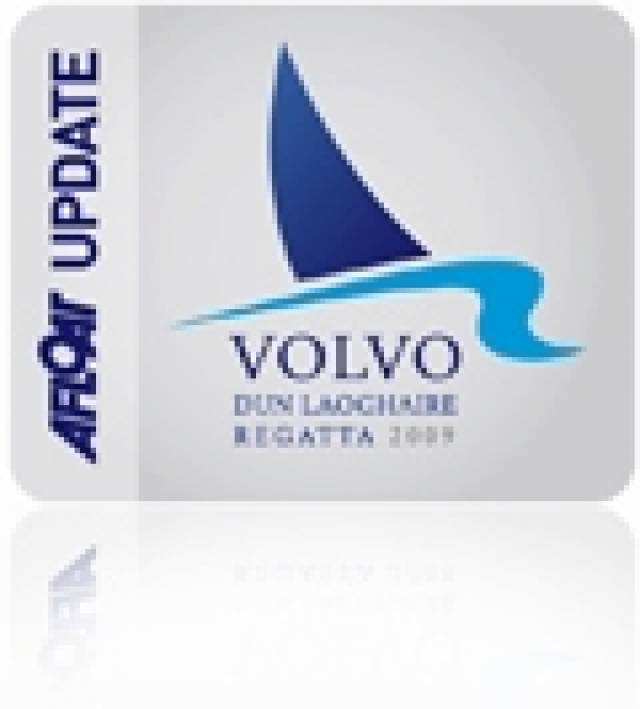#vdlr2013 – Inshore and offshore campaigner John Maybury's J109, Joker II, continues her winning form this season after victory in this afternoon's light and shifty opening race of the 2013 Volvo Dun Laoghaire regatta.
Nearly 3000 sailors are afloat on Dublin Bay for the four day regatta that is the biggest sailing event in the Irish Sea area. The event hit the headlines yesterday with a full page entry list of all competing boats in the Irish Times. The value of the event is estimated by organisers to be worth €600k to the local economy.
The regatta got off to a prompt start in spite of forecasts of no wind, with all 25 classes completing the first day's programme.
Local sailor Maybury, from the Royal Irish Yacht Club, who was a class winner in June's Sovereign's Cup, took the first race of the 14–boat J109 fleet by a considerable margin, making every use of multiple Olympic keelboat helmsman Mark Mansfield on board.
Second was John Collins in Jet Stream from Pwllheli Sailing Club. His club mate, the ISORA offshore champion, Sgrech, sailed by Stephen Tudor was third.
Conditions could not have been more different than the first race this time two years ago when strong southerly winds gusted to gale force in the biennial event.
Today was equally as testing but for completely different reasons as sailors struggled to keep sails filling in the gentle sea breeze and strong sunshine that prevailed. 'It was light and shifty, you really had to keep your head out of the boat' said Mansfield, a veteran of the 1992, 1996, 2000 and 2004 Olympics in the Star keelboat.
Racing is being staged until Sunday over eight separate courses and a combined fleet of 393 boats, with 120 visiting yachts.
An impressive line up of 12 class zero boats has made Volvo Dun Laoghaire regatta the biggest turnout this year for the 40-footers.
Ten are visiting boats, but first race honours are staying local with Howth's well campaigned Mills 36 Crazy Horse (Alan Chambers and Norbert Reilly) taking a win from the Clyde based First 40, Zephyr (Stephen Cowie). Third this afternoon was Swansea's Dark Angel, a Dubois 37 skippered by Anthony Ackland.
In Class one's 16–boat fleet the recently crowned Irish class one champion Bon Exemple, a new Xp33 design, is on top again beating Fairlie's Mat1010 in the opening round. Third was Paul O'Higgin's Rockabill from the Royal Irish Yacht Club.
Yachts are sailing different courses including trapezoid, windward–leeward, and triangular configurations. This year for the first time there is also a coastal division but no winners details are available so far, with this 16-boat division only returning to harbour last night (under engine) at 1930.
The 2011 winner of the overall Volvo trophy Ken Lawless is back in contention again but in a different boat.
His new vintage quarter tonner Cartoon was fifth in today's opening race in one of the regatta's biggest fleets today but taking the gun in this 24-boat division is the IRC Class three National Champion Quest, skippered by Barry Cunningham of the Royal Irish Yacht Club.
In the one design and dinghy divisions, sailing in the centre or the north west of the bay, there were plenty of familiar names at the top of the fleets.
Tim Goodbody leads the Sigma 33s, Ian Mathews the Flying fifteens, Gerry O'Connor the Squibs and Michael O'Connor in the SB20s.
Sailing in Seapoint bay with a 120 degree wind, a nine boat Fireball fleet sailed two races with winds strong enough for marginal trapezing. Both counting a 1 and a 2, the Clancy Brothers are tied with Brian Byrne and Stephen Campion for first place. More on the Fireball racing here.
Racing continues tomorrow (Friday).
Day one provisional selected results
IRC CLASS 0 1. Crazy Horse (Chambers/ Reilly) 2. Zephyr (S Cowie) 3. Dark Angel (A Ackland)
IRC CLASS 1 1. Bon Example (X Yachts GB) 2. Now or Never 3 (N Stafford) 3. Rockabill V (P O'Higgins)
IRC CLASS 2 1. Checkmate XV (N Biggs) 2. Scenario Encore (S&J Fitton) 3. Tribal (L Burke)
J109 1. Joker II (J Maybury) 2. Jet Stream (J Collins) 3. Sgrech (S Tudor)
SIGMA 33 1. White Mischief (T Goodbody) 2. Leaky Roof 2 (A Harper/ E&K Robertson) 3. Rupert (R&P Lovegrove)
BENETEAU 31.7 1. Eauvtion (J&D Corlett) 2. Twister (Byers/ Fletcher/ Fair) 3. Prospect (C Johnston)
































































